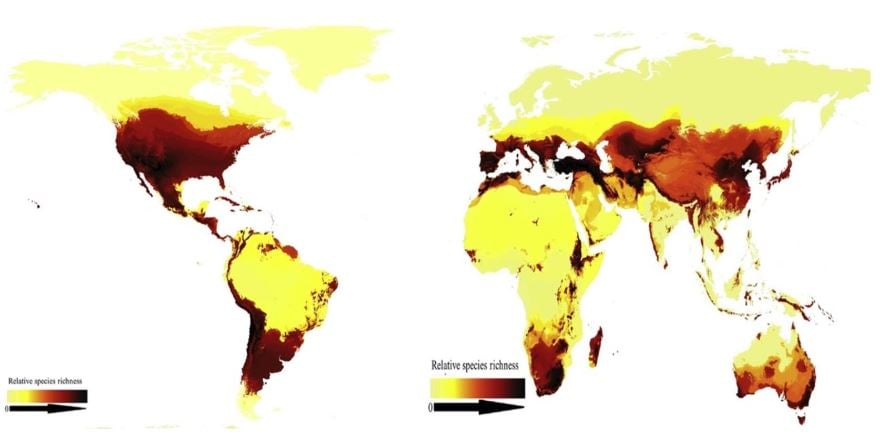Bees are important pollinators, they provide an essential service required for both the ecosystem and humans as several food crops rely on insect pollination. Particular species such as the honey bee, provide hive products that have a variety of use from food to medicinal. In Australia, native bee species are effective pollinators of native flora.
The feat of working out the global distribution of bees was done in a paper published in Current Biology in 2021. This team compiled over 5.8 million public bee records from 5 public databases and over 20 000 bee species to map out where bee species are seen.

Figure 1. Distribution of relative bee species richness (i.e. number of bee species) globally. The higher the projected richness, the darker the colour. Figure: Courtesy Orr et al., 2021.
So where are the bees?
As seen in the map above, the authors saw the greatest number of bee species at mid-lattitude in both Northern and Southern hemisphere. This gradient means that the number of bee species is greater away from the equator and the poles. In terms of habitats, thats more bee species in xeric (dry environmental conditions) temperate areas and arid deserts, rather than in tropical habitats. This follows the previous hypothesis by Charles Michener (2007). It is likely the humid environment of the tropics negatively impacts larval food and there is higher predation of ants on bee larvae.
It should be acknowledged that as this study is based mostly on citizen science, several regions of Africa and Asia are not well covered. Further, several bees are solitary, increasing the difficulty in them being spotted. The data depends on human populations with access to technology and inclination to collect data being present. Further, data for Australia is mostly limited to coastal areas, but native bee species are known to be found throughout warmer regions of Australia including Northern WA, the Northern Territory, Queensland, northern and coastal NSW. This indicates that there are limitations to the dataset.
What is driving bee distribution?
There were 18 variables influencing global bee distribution. Some of the variables are:
- Available solar energy with low variation. Bee species richness is linked to places that have sunlight. No plants, no bees. Temperature is also important for thermoregulation
- Plant productivity. Unsurprisingly, bee species richness is linked to high plant productivity. However, this does not include trees and forests. In fact, the number of bee species decreases in forest habitats
- Low (but not no) precipitation in dry months.
- Humidity. High humidity decreased species richness, this is linked to water having a negative relationship to bee species richness.
- Lower wind levels. This means that areas of low elevation, which experience less wind, have more bee species than high elevation.
What is the importance?
This study provides the first global snapshot to understand the distribution of bee species. The results will allow us to assess how climatic factors may influence bees directly or via their influence on plants. With global warming being a very current topic, this paper becomes a baseline for predicting how bee distribution may shift in the future and allow us to assess conservation strategies and management. This is significant as honey bee stock alone can’t meet the pollination requirements of the world, putting greater importance on our wild pollinator species.
Acknowledgements:
- Orr, M., Hughes, A., Chesters, D., Pickering, J., Zhu, C. and Ascher, J., 2021. Global Patterns and Drivers of Bee Distribution. Current Biology, 31(3), pp.451-458.e4.
- Michener C.D. (2000), The Bees of the World. JHU Press, pp. 96-98.
- This article was peer-reviewed by Nadine Chapman and Patsavee Utaipanon.

